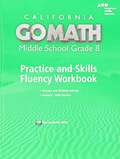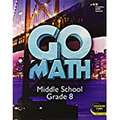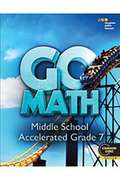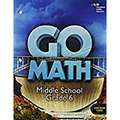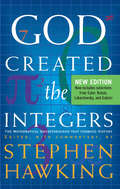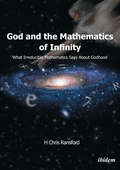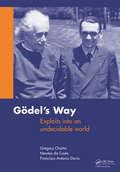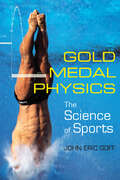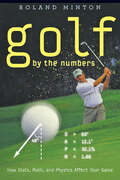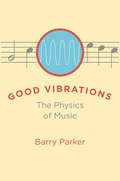- Table View
- List View
Go Math!: Practice Fluency Workbook Grade 8 (Go Math! Series)
by Holt McDougalMath instruction is always evolving, with new approaches to pedagogy, engagement, and technology. GO Math!® meets students and teachers on their math journey, raising student achievement scores and supporting teachers along the way. <p><p> Designed by the same author team across K–8, GO Math! incorporates the latest thinking in its comprehensive approach and engages digital natives with cross-platform technology. It helps teachers to differentiate instruction, building and reinforcing foundational math skills that translate from the classroom to real life.
Go Math!: Student Interactive Worktext (Grade #6)
by Timothy D. Kanold Edward B. Burger Juli K. DixonGo Math!: Student Interactive Worktext (Grade #8)
by Houghton Mifflin HarcourtGo Math!: Student Interactive Worktext (Grade 8)
Go Math!: Student Interactive Worktext Grade 8 2014 (Go Math! Ser.)
by Holt McdougalGo Math!: Student Interactive Worktext Grade 8
Go Math!: Student Interactive Worktext, Grade 7
by Houghton StaffHMH Go Math!: Student Interactive Worktext, Grade 7, 2018 Common Core Edition
Go Math, Grade 6, Middle School, Practice and Skills Fluency Workbook
by Houghton Mifflin HarcourtNIMAC-sourced textbook
Go Math, Grade 8, Middle School: Student Edition 2018 (Go Math! (StA))
by Timothy D. Kanold Edward B. Burger Juli K. DixonNIMAC-sourced textbook
Go Math, Middle School, Accelerated Grade 7
by Timothy D. Kanold Edward B. Burger Juli K. DixonNIMAC-sourced textbook
Go Math, Middle School, Grade 6
by Timothy D. Kanold Edward B. Burger Juli K. DixonNIMAC-sourced textbook
Go Math, Middle School, Grade 6
by Timothy D. Kanold Edward B. Burger Juli K. DixonNIMAC-sourced textbook
Go Math, Middle School, Grade 7
by Timothy D. Kanold Edward B. Burger Juli K. DixonNIMAC-sourced textbook
Go Math, Middle School, Grade 8
by Timothy D. Kanold Edward B. Burger Juli K. DixonNIMAC-sourced textbook
Go Math, Middle School, Grade 8
by Timothy D. Kanold Edward B. Burger Juli K. DixonNIMAC-sourced textbook
Go Math: Middle School, Grade 7
by Timothy D. Kanold Edward B. Burger Juli K. Dixon Steven J. Leinwand Matthew R. Larson Martha E. Sandoval-MartinezThis textbook for 7th graders covers essential math topics, with study guide reviews and assessments.
Go To: The Story of the Math Majors, Bridge Players, Engineers, Chess Wizards, Maverick Scientists and Iconoclasts- the Programmers Who Created the Software Revolution
by Steve LohrIn Go To, Steve Lohr chronicles the history of software from the early days of complex mathematical codes mastered by a few thousand to today's era of user-friendly software and over six million professional programmers worldwide. Lohr maps out the unique seductions of programming, and gives us an intimate portrait of the peculiar kind of genius that is drawn to this blend of art, science, and engineering, introducing us to the movers and shakers of the 1950s and the open-source movement of today. With original reporting and deft storytelling, Steve Lohr shows us how software transformed the world, and what it holds in store for our future.
God Created the Integers: The Mathematical Breakthroughs that Changed History
by Stephen HawkingBestselling author and physicist Stephen Hawking explores the masterpieces of mathematics, 25 landmarks spanning 2,500 years and representing the work of 15 mathematicians. "
God and the Mathematics of Infinity: What Irreducible Mathematics Says about Godhood
by H. Chris RansfordDrawing on the science and mathematics of infinity, H. Chris Ransford analyzes the traditional concept of godhood and reaches surprising conclusions. He addresses humankind's abiding core debate on the meaning of spirituality and God. Using mathematics, he explores key questions within this debate: for instance, why does evil exist if there is a God? The book fastidiously does not take sides nor proffers opinions, it only follows allowable mathematics wherever it leads. By doing so, it makes a major contribution to an understanding of the nature of reality.
Goedel's Way: Exploits into an undecidable world
by Gregory Chaitin Newton da Costa Francisco DoriaKurt Gödel (1906-1978) was an Austrian-American mathematician, who is best known for his incompleteness theorems. He was the greatest mathematical logician of the 20th century, with his contributions extending to Einstein’s general relativity, as he proved that Einstein’s theory allows for time machines.The Gödel incompleteness theorem - the usual formal mathematical systems cannot prove nor disprove all true mathematical sentences - is frequently presented in textbooks as something that happens in the rarefied realms of mathematical logic, and that has nothing to do with the real world. Practice shows the contrary though; one can demonstrate the validity of the phenomenon in various areas, ranging from chaos theory and physics to economics and even ecology. In this lively treatise, based on Chaitin’s groundbreaking work and on the da Costa-Doria results in physics, ecology, economics and computer science, the authors show that the Gödel incompleteness phenomenon can directly bear on the practice of science and perhaps on our everyday life.This accessible book gives a new, detailed and elementary explanation of the Gödel incompleteness theorems and presents the Chaitin results and their relation to the da Costa-Doria results, which are given in full, but with no technicalities. Besides theory, the historical report and personal stories about the main character and on this book’s writing process, make it appealing leisure reading for those interested in mathematics, logic, physics, philosophy and computer sciences. See also: http://www.youtube.com/watch?v=REy9noY5Sg8
Gold Medal Physics: The Science of Sports
by John Eric GoffNothing is quite as thrilling as watching superior athletes do the seemingly impossible. From Doug Flutie's "Hail Mary" pass to Lance Armstrong's record-breaking climb of Alp d'Huez to David Beckham's astounding ability to bend a soccer kick, we marvel and wonder, "How did they do that?" Well, physics professor John Eric Goff has the answers.This tour of the wide world of sports uses some of the most exhilarating feats in recent athletic history to make basic physics concepts accessible and fun. Goff discusses the science behind American football, soccer, cycling, skating, diving, long jumping, and a host of other competitive sports. Using elite athletes such as Greg Louganis and Bob Beamon as starting points, he explains in clear, lively language the basic physical properties involved in amazing and everyday athletic endeavors. Accompanied by illustrations and mathematical equations, each chapter builds on knowledge imparted in earlier portions of the book to provide a firm understanding of the concepts involved.Fun, witty, and imbued throughout with admiration for the simple beauty of physics, Gold Medal Physics is sure to inspire readers to think differently about the next sporting event they watch.
Gold Medal Physics: The Science of Sports
by John Eric GoffA physicist explains the science behind some of the greatest feats in sports history—from diving like Greg Louganis to bending it like Beckham.Nothing is quite as thrilling as watching superior athletes do the seemingly impossible. From Doug Flutie's "Hail Mary" pass to Lance Armstrong's record-breaking climb of Alp d'Huez to David Beckham's astounding ability to bend a soccer kick, we marvel and wonder, "How did they do that?" Well, physics professor John Eric Goff has the answers.In this scientific tour of the wide world of sports, John Eric Goff discusses the science behind American football, soccer, cycling, skating, diving, long jumping, and a host of other competitive sports. Using elite athletes as starting points, Goff explains the basic physical properties involved in amazing and everyday athletic endeavors. Accompanied by illustrations and mathematical equations, each chapter builds on knowledge imparted in earlier chapters to provide a firm understanding of the concepts involved.Fun, witty, and imbued throughout with admiration for the simple beauty of physics, Gold Medal Physics is sure to inspire readers to think differently about the next sporting event they watch.
Goldbach’s Problem
by Michael Th. RassiasImportant results surrounding the proof of Goldbach's ternary conjecture are presented in this book. Beginning with an historical perspective along with an overview of essential lemmas and theorems, this monograph moves on to a detailed proof of Vinogradov's theorem. The principles of the Hardy-Littlewood circle method are outlined and applied to Goldbach's ternary conjecture. New results due to H. Maier and the author on Vinogradov's theorem are proved under the assumption of the Riemann hypothesis. The final chapter discusses an approach to Goldbach's conjecture through theorems by L. G. Schnirelmann. This book concludes with an Appendix featuring a sketch of H. Helfgott's proof of Goldbach's ternary conjecture. The Appendix also presents some biographical remarks of mathematicians whose research has played a seminal role on the Goldbach ternary problem. The author's step-by-step approach makes this book accessible to those that have mastered classical number theory and fundamental notions of mathematical analysis. This book will be particularly useful to graduate students and mathematicians in analytic number theory, approximation theory as well as to researchers working on Goldbach's problem.
Golden Numbers: A California Number Book
by David DomeniconiCalifornia's symbols, facts, landscapes, and history are introduced using numbers. Each subject is introduced with a poem, followed by more detailed information. Topics include volcanoes, presidios, the desert tortoise, frogs, and monarch butterflies.
Golf by the Numbers: How Stats, Math, and Physics Affect Your Game
by Roland MintonHow do the world’s greatest golfers improve their game? Practice, sure, but Roland Minton says mathematics and statistics are also key to their success. Golf by the Numbers analyzes the mathematical strategies behind the sport, giving fans a behind-the-scenes look at how numbers drive the game.Computers, GPS trackers, swing simulators, and high-speed cameras have introduced new and exciting ways of seeing and understanding the complicated and endlessly fascinating game of golf. Players like Phil Mickelson are so good because they review the results of every swing they take. Minton’s comprehensive analysis of statistics taken from the PGA Tour’s ShotLink system walks readers through the mountains of data that pros use to inform and refine their play. The result is an insider’s perspective of how the world’s greatest golfers apply mathematics to the sport.Minton discusses randomness in golf (especially how much luck is involved in putting) as well as aggressive and cautious strategies both on and off the greens, and he explains, by the numbers, just how Tiger Woods was so dominant from 2004 to 2009.Here is a book that tells some truly engaging stories of modern golf, featuring famous players and memorable tournaments, all through the lens of elementary probability theory. Minton’s informal style and clear and direct explanations make even the most detailed discussions accessible to all curious-minded golfers. His mathematical morsels are not only enjoyable to read—they may even help you improve your game.
Good Math: A Geek's Guide to the Beauty of Numbers, Logic, and Computation
by Mark C. Chu-CarrollMathematics is beautiful--and it can be fun and exciting as well as practical. Good Math is your guide to some of the most intriguing topics from two thousand years of mathematics: from Egyptian fractions to Turing machines; from the real meaning of numbers to proof trees, group symmetry, and mechanical computation. If you've ever wondered what lay beyond the proofs you struggled to complete in high school geometry, or what limits the capabilities of computer on your desk, this is the book for you.Why do Roman numerals persist? How do we know that some infinities are larger than others? And how can we know for certain a program will ever finish? In this fast-paced tour of modern and not-so-modern math, computer scientist Mark Chu-Carroll explores some of the greatest breakthroughs and disappointments of more than two thousand years of mathematical thought. There is joy and beauty in mathematics, and in more than two dozen essays drawn from his popular "Good Math" blog, you'll find concepts, proofs, and examples that are often surprising, counterintuitive, or just plain weird.Mark begins his journey with the basics of numbers, with an entertaining trip through the integers and the natural, rational, irrational, and transcendental numbers. The voyage continues with a look at some of the oddest numbers in mathematics, including zero, the golden ratio, imaginary numbers, Roman numerals, and Egyptian and continuing fractions. After a deep dive into modern logic, including an introduction to linear logic and the logic-savvy Prolog language, the trip concludes with a tour of modern set theory and the advances and paradoxes of modern mechanical computing.If your high school or college math courses left you grasping for the inner meaning behind the numbers, Mark's book will both entertain and enlighten you.
Good Vibrations: The Physics of Music
by Barry ParkerWhy does a harpsichord sound different from a piano? For that matter, why does middle C on a piano differ from middle C on a tuning fork, a trombone, or a flute? Good Vibrations explains in clear, friendly language the out-of-sight physics responsible not only for these differences but also for the whole range of noises we call music.The physical properties and history of sound are fascinating to study. Barry Parker's tour of the physics of music details the science of how instruments, the acoustics of rooms, electronics, and humans create and alter the varied sounds we hear. Using physics as a base, Parker discusses the history of music, how sounds are made and perceived, and the various effects of acting on sounds. In the process, he demonstrates what acoustics can teach us about quantum theory and explains the relationship between harmonics and the theory of waves.Peppered throughout with anecdotes and examples illustrating key concepts, this invitingly written book provides a firm grounding in the actual and theoretical physics of music.
